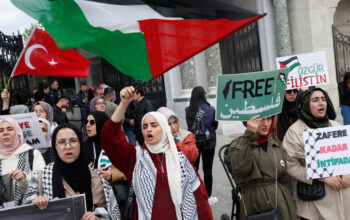
Her name was Simone Segouin, but she was known by her nom de guerre, Nicole.
That’s how Jack Belden, a Life magazine war correspondent, came to know that armed teenage French resistance fighter after he entered Chartres, France, with the United States Third Army in August 1944, around the time of the city’s liberation from German occupation.
“She was clad in a light-brown jacket and a cheap flowered skirt of many hues, which ended just above her knees,” Mr. Belden wrote. “Her legs were bare and brown. About her arm went a ribband bearing the legend FTPF. In the waistband of her skirt was stuck a small revolver.”
The FTPF, the Francs-tireurs et partisans français, was one of the most effective militias of the French resistance.
“Under my stumbling French questioning,” Mr. Belden wrote, “she admitted that she was a partisan fighter.”
His article, headlined “The Girl Partisan of Chartres” in the Sept. 4, 1944, issue of Life, made “Nicole” an international symbol of the French resistance. Its sub-headline — “Pretty 17-year-old Nicole tells Life’s war reporter the story of how she killed a Boche,” French slang for a German — offered a whiff of the sensational.
When President Emmanuel Macron of France announced her death, in Courville-sur-Eure, France, on Feb. 21, he cited the article in the second sentence of a news release. She was 97.
“The article gave her a larger-than-life profile,” Robert Gildea, the author of “Fighters in the Shadows: A New History of French Resistance,” wrote in an email. “Most women resisters operated in the shadow and were modest about their resistance activities.”
She was hardly in the shadows the morning after her first meeting with Mr. Belden, when she and several comrades led into town 25 German soldiers they had captured hours earlier at a mill.
“As the column drew abreast of a group of U.S. soldiers, the G.I.s let out a series of whistles,” he wrote. “At the end of the column walked the partisan girl, nonchalantly holding a German Schmeisser pistol. When she had taken the prisoners to the M.P.s, she walked over to me, and for the first time I noticed a little shyness in her, as if she were trying to hide her pride in her accomplishments from an American.”
Simone Segouin was born on Oct. 3, 1925, in Thivars, France, south of Chartres. After the war began, her father let partisans use the family farm as a hide-out. Through those encounters, she met Lt. Roland Boursier, a local resistance leader, code-named Germain, in early 1944.
“When I discovered she had French feelings, I told her little by little about the work I was doing,” Lt. Boursier told Life. “I asked her if she would be scared to do such work. She said, ‘No it would please me to kill Boches.’”
Given false papers saying she was Nicole Minet, of Dunkirk, Ms. Segouin ferried messages and weapons among members of the local partisan network on a bicycle she had stolen from a German. Lt. Boursier said he taught her how to use submachine guns, rifles and handguns. According to President Macron’s office, she also helped the partisans sabotage German troop trains.
“Nothing pleased Nicole so much as the killing of the Germans,” Mr. Belden wrote in Life, but she was not sure if she had ever killed anyone. In 2014, she recalled being involved in an ambush.
“Two German soldiers went by on a bike and three of us fired at the same time,” her obituary in The Telegraph quoted her as once saying, “so I don’t know who exactly killed them.”
After the liberation of Chartres, she and other members of her resistance group went to Paris with the American Second Armored Division, fighting for several days until Germany surrendered the city on Aug. 25.
During the fighting, she was photographed with two comrades, her weapon ready, by the renowned photojournalist Robert Capa. At least one of his photos also appeared in Life, a week after the Belden article.
Mr. Belden was not the only American to find Ms. Segouin a worthy symbol of the French Resistance. George Stevens, the Hollywood film director, took his United States Army Signal Corps crew to Chartres but used his personal camera to capture her, with a slight smile, and a submachine gun slung over her right shoulder.
On the day after Paris’s liberation, Ms. Segouin marched in a victory parade only steps away from Gen. Charles de Gaulle, leader of the Free French Forces, down the Champs-Élysées.
After the war, she was promoted to lieutenant and received the Croix de Guerre, a military honor for heroism in combat. She worked as a pediatric nurse. A street in Courville-sur-Eure was named after her.
Information about her survivors was not available.
When she received the Soldiering On International Award from a British military charity in 2016, Ms. Segouin said that her proudest moment as a member of the resistance “was probably going to Paris with Gen. Charles de Gaulle.”
“It was a wonderful feeling entering the city,” she said, “but my excitement was limited because it felt very dangerous.”
Kirsten Noyes contributed research.


